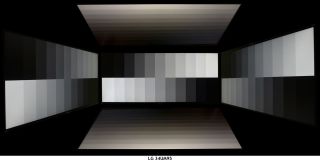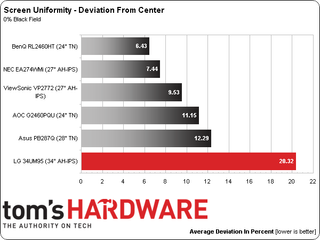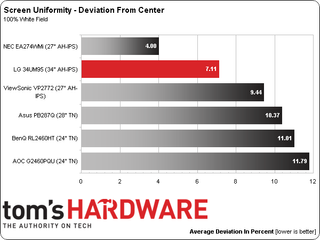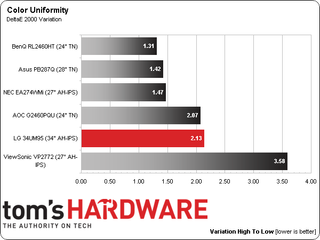LG 34UM95 34-Inch Ultra-Wide QHD Monitor Review
When we looked at 29-inch ultra-wide displays last year, we asked for greater size and more pixels. LG answers that request with its 34UM95, a 34-inch panel with a resolution of 3440x1440. Today we run it through our performance and usability analysis.
Results: Viewing Angles And Uniformity
The more monitors we test, the more we can see that off-axis viewing performance is dependent not only on pixel structure (IPS, PLS, TN, etc.) but the backlight technology as well. And we can see that the anti-glare layer makes a difference too.

When a monitor is as wide as the 34UM95, off-axis performance needs to be top-notch, and it is. These are the best horizontal viewing photos we’ve ever seen. Aside from a little light reduction, the gray step pattern looks the same from a 45-degree angle as it does head-on. Meanwhile, in the vertical plane, there is a red shift along with lower brightness and a loss of detail in the darker steps. Still, I'd say this represents a step forward for IPS panels in general.
Screen Uniformity: Luminance
To measure screen uniformity, zero and 100-percent full-field patterns are used, and nine points are sampled. First, we establish a baseline measurement at the center of each monitor. Then the surrounding eight points are measured. Their values get expressed as a percentage of the baseline, either above or below. This number gets averaged. It is important to remember that we only test the review sample each vendor sends us. Other examples of the same monitor can measure differently in this metric.
First up is black field uniformity.

In excess of 20 percent isn't the worst result we've recorded, but it is higher than almost every other monitor we've tested. The culprit is along the bottom edge, where hotspots are fairly easy to see. There are also light areas at the top edge. Obviously, that is where the backlight LEDs are located.
Here’s the white field measurement:

Fortunately, the above result doesn’t translate to the white field measurement. In fact, as brightness increases, the screen appears more and more uniform.
Stay on the Cutting Edge
Join the experts who read Tom's Hardware for the inside track on enthusiast PC tech news — and have for over 25 years. We'll send breaking news and in-depth reviews of CPUs, GPUs, AI, maker hardware and more straight to your inbox.
Even though these tests show a weak point in the 34UM95, it doesn’t diminish other areas where the display performs well. Overall image quality is still very good.
Screen Uniformity: Color
To measure color uniformity, we display an 80-percent white field and measure the Delta E error of the same nine points. Then we simply subtract the lowest value from the highest to come up with a result. Smaller numbers mean a display is more uniform. Any value below three means a variation that is invisible to the naked eye.

Almost all of the monitors we measure have no visible color shift across the screen; LG's 34UM95 is no exception. In fact, only the bottom-right corner shows any significant difference in color accuracy. Even that error wasn't visible to me.
Current page: Results: Viewing Angles And Uniformity
Prev Page Results: Color Gamut And Performance Next Page Results: Pixel Response, Input Lag, And Usability
Christian Eberle is a Contributing Editor for Tom's Hardware US. He's a veteran reviewer of A/V equipment, specializing in monitors. Christian began his obsession with tech when he built his first PC in 1991, a 286 running DOS 3.0 at a blazing 12MHz. In 2006, he undertook training from the Imaging Science Foundation in video calibration and testing and thus started a passion for precise imaging that persists to this day. He is also a professional musician with a degree from the New England Conservatory as a classical bassoonist which he used to good effect as a performer with the West Point Army Band from 1987 to 2013. He enjoys watching movies and listening to high-end audio in his custom-built home theater and can be seen riding trails near his home on a race-ready ICE VTX recumbent trike. Christian enjoys the endless summer in Florida where he lives with his wife and Chihuahua and plays with orchestras around the state.
-
rantoc 4k gaming is amazing but demand alot from the computer hardware. Just got a dell 3214 and its hard to describe how much better the picture/emersion is with the way higher definition in the picture quality and still came from descent 2560x1600 before that.Reply
Playing on "full" hd (LD? Low definition) feels like a joke once you get to know uhd/4k -
wtfxxxgp Rantoc, what does your comment have to do with the article? Seems to me that you were waiting for an opportunity to brag about your new monitor... Glad you got that out of your system. lolReply
With regards to this monitor...I LOVE the looks...very elegant. I think the price tag is fitting as well - it has great resolution and there are still plenty of people who are gaming on 60hz displays that may have just enough GPU power to actually game at this thing's native resolution, albeit with slightly lower settings. GG LG! -
xPandaPanda I have this monitor. Because of it's cinema format, market age, lower production numbers, and early adoption as competitors haven't offered this yet, it is reasonable to think this monitor would cost this much--a lot.Reply
It would have been nice to include what revision this is, because LG is aware of uniformity issues, which is why the product was largely on backorder and a Rev.2 is in place (but Rev. 2 didn't fix the problem either). My first one had a glaring Uniformity problem, but LG is cool and offered an advanced exchange. The new one has some uniformity problem, but it is very 'livable' and discrete.
Overall, I am pleased with this product. I have a single 780 to push this and it works nicely. If I got a 4k monitor, I'd have performance issues as the GPU as a whole sector is behind.
-
eklipz330 as a pc gamer who has been playing for ~15 years, i have to say that this is one of the biggest changes that i've seen on the pc platform. this is a big step towards bringing pc back to relevancy. it's something that will be held to acclaim in productive and gaming environments. in fact, the only thing that i'm surprised that they didn't do is make it curved, simply because when a user sets up a multi-monitor setup, they set the outside monitors at an angle. this makes curved monitor solutions make sense more so than tvs, especially since curved monitors benefit solo users the most. im shocked they didnt make it curved. probably going to cash in next year on that.Reply
seriously though, pc monitors have been lacking for some years now, falling behind in innovation and technology in general(phones have been jacking up their screen quality year after year, we've been stuck since like 2005). i bet 21:9 screens will have the biggest penetration on PCs. -
josejones Why still the old HDMI 1.4 instead of HDMI 2.0 and DisplayPort 1.2 instead of the new 1.4 ???Reply
Most Popular

